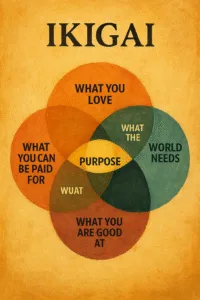Finding Your Ikigai: Why Every Business Owner Needs a Reason Beyond the Bottom Line
Finding Your Ikigai: Why Every Business Owner Needs a Reason Beyond the Bottom Line
By Ryan Gartrell, Business Operations Consultant | Writer | Lean AI Expert
The spreadsheet said yes. The bank said yes. The customers said yes. So why does it feel like no?
Why do so many business owners—on paper, successful—wake up with anxiety, burnout, or apathy? Why do they spend their weekends searching real estate in Bali or Lisbon, or Googling “how to sell my company without tanking it”?
The answer isn’t in your P&L. It’s in your purpose.
And for that, we need to talk about ikigai.

What Is Ikigai (And Why Does It Matter More Than Ever)?
Ikigai is a Japanese concept that loosely translates to “reason for being.” It sits at the intersection of four elements:
- What you love
- What you’re good at
- What the world needs
- What you can be paid for
When all four align, work becomes sustainable—not just financially, but emotionally and spiritually. When one is missing, we fall into imbalance:
- Get paid for something you’re good at but don’t love? Burnout.
- Love what you do but it doesn’t serve a need? Irrelevance.
- Do something the world needs but it doesn’t pay? Resentment.
In a business world obsessed with scale and speed, ikigai is a demand for depth.
The Myth of Fulfillment Through Profit
Capitalism is transactional. Ikigai is relational.
When your business is only built to extract revenue, it will eventually extract purpose, too. That’s why so many founders and CEOs find themselves emotionally bankrupt even as the company grows.
You optimized your marketing funnel—but forgot why you built it. You hired a team—but never told them what you truly believe in. You sold to your ideal customer—but don’t care if they come back.
As the philosopher Alan Watts said, “You’re paid to be busy, but not to be alive.”
Why Every Business Owner Should Complete an Ikigai Map
At RyanGartrell.com, we work with clients to optimize systems, cut operational waste, and improve efficiency. But what we’ve learned—especially from our Operations Reset and Lean AI® work—is that no system will succeed if the leader is misaligned.
That’s why we now integrate ikigai mapping as part of our leadership diagnostic.
Because knowing your purpose changes how you:
- Build your offers
- Communicate your values
- Lead your team
- Sell without sounding like a spreadsheet
- Say no to what looks good but doesn’t feel right
You cannot delegate direction. If you don’t know why you’re doing it, neither will your team. Or your customers. Or your future self.
What Ikigai Looks Like in Practice
We recently worked with a founder who built a wildly successful agency—but hated it. Revenue was great. Culture was toxic. She was bored, stuck, and ready to burn it all down.
After a full operational audit, we stopped talking strategy and started talking purpose.
She didn’t need to pivot industries. She needed to rebuild her offers around what she actually gave a damn about: helping people with brands that felt like real stories, not just templates.
She raised prices. Fired three clients. Rebuilt her onboarding. Delegated. Now, her revenue is higher. Her calendar is lighter. Her team knows what matters.
That’s ikigai in action. Not poetry. Precision.
Angry Shrimp’s Take: Clarity = Conversion
Our sister company, Angry Shrimp Media, works on the marketing side of the same problem. We’ve seen campaigns flatline not because the message was bad—but because the founder didn’t believe it.
You cannot fake alignment. People feel it. Algorithms measure it.
Whether you’re optimizing funnels or brand identity, clarity starts inside.
Conclusion: Stop Asking What You Do. Ask Why It Still Matters.
Ikigai is not a personal development tool. It’s an operational asset.
It changes how you hire, scale, market, and lead. It turns performance into purpose. It gives your systems something to serve.
At Ryan Gartrell Consulting, we don’t just help you run faster. We help you remember where you’re going.
Let us help you find your ikigai—and build a business around it.
External Reference:
